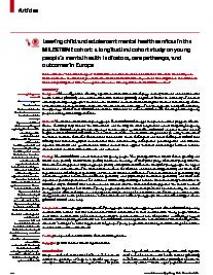Leaving child and adolescent mental health services in the MILESTONE cohort : a longitudinal cohort study on young people’s mental health indicators, care pathways, and outcomes in Europe
Background: The configuration of having separate mental health services by age, namely child and adolescent mental health services (CAMHS) and adult mental health services (AMHS), might be a barrier to continuity of care that adversely affects young people’s mental health. However, no studies have investigated whether discontinuity of care in the transition period affects mental health. We aimed to discern the type of care young people receive after reaching the upper age limit of their CAMHS and examine differences in outcomes at 24-month follow-up between young people receiving different types of care.
Methods: To assess mental health in young people from 39 CAMHS in eight European countries (Belgium, Croatia, France, Germany, Italy, Ireland, the Netherlands, and the UK), we did a longitudinal cohort study. Eligible young people were CAMHS users up to 1 year younger than the upper age limit of their CAMHS or up to 3 months older, if they were still in CAMHS. Information on mental health service use, mental health problems (ie, using the Health of the Nation Outcome Scale for Children and Adolescents, Youth Self-Report and Adult Self-Report, DSM-5, and ICD-10), and sociodemographic characteristics were collected using self-reported, parent-reported, and clinicianreported interviews and questionnaires. Mixed models were applied to assess relationships between baseline characteristics, mental health service use, and outcomes.
Findings: The MILESTONE cohort included 763 young people. The participants were 60·0% female (n=458) and 40·0% male (n=305), 90·3% White (n=578), and had a mean age of 17·5 years (range 15·2–19·6 years). Over the 24-month follow-up period, 48 young people (6·3%) actively withdrew from the study. For young people, the higher their scores on the Health of the Nation Outcome Scale for Children and Adolescents (p=0·0009) and Youth Self- Report and Adult Self-Report (p=0·046), and who had a clinical classification of severe mental illness (p=0·0033), had suicidal thoughts or behaviours or self-harm (p=0·034), used psychotropic medication (p=0·0014), and had a selfreported or parent-reported need for continued treatment (p<0·0001) at baseline, were more likely to transition to AMHS or stay in CAMHS than to have care end. Overall, over the 24-month follow-up period, the mental health of young people improved, but 24·4% of young people reported an increase in problems calculated using the reliable change index, of whom 5·3% had a clinically relevant increase in problems. At 24-month follow-up, no differences in change in mental health problems since baseline were found between young people who used different types of care (CAMHS, AMHS, or no care).
Interpretation: Although approximately half of young people reaching the upper age limit of their CAMHS stop using mental health services, this was not associated with a deterioration in their mental health. Young people with the most severe mental health problems are more likely to receive continued care. If replicated, our findings suggest investments in improving transitional care for all CAMHS users might not be cost-effective in times of rising healthcare costs, but might be better targeted at a subgroup of young people with increasing mental health problems who do not receive continued treatment.
Geachte bezoeker,
De informatie die u nu opvraagt, kan door psychotraumanet niet aan u worden getoond. Dit kan verschillende redenen hebben,
waarvan (bescherming van het) auteursrecht de meeste voorkomende is. Wanneer het mogelijk is om u door te verwijzen naar de bron
van deze informatie, dan ziet u hier onder een link naar die plek.
Als er geen link staat, kunt u contact opnemen met de bibliotheek,
die u verder op weg kan helpen.
Met vriendelijke groet,
Het psychotraumanet-team.
In: Lancet Psychiatry ; ISSN: 2215-0366 | 9 | 12 | december | 944-956
https://doi.org/10.1016/S2215-0366(22)00310-8


